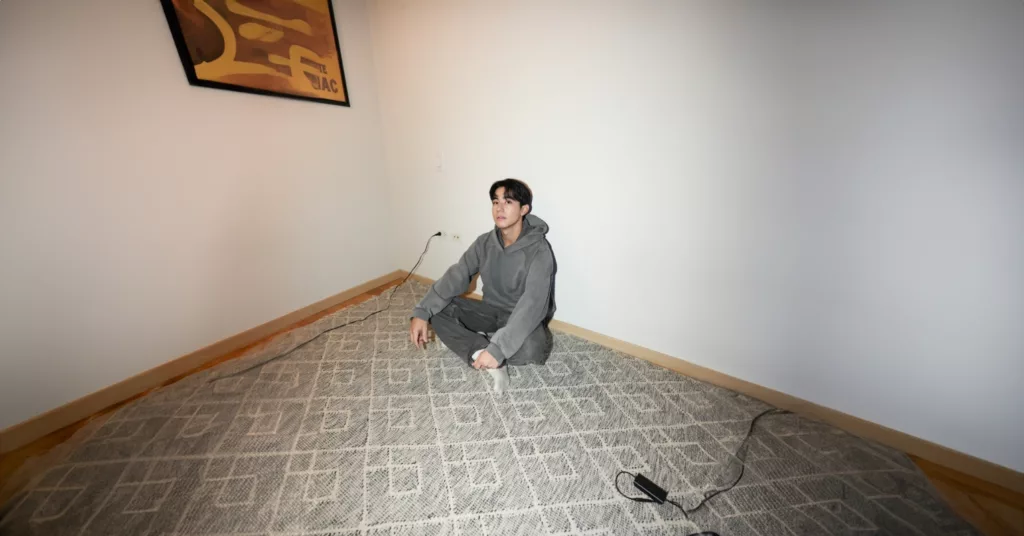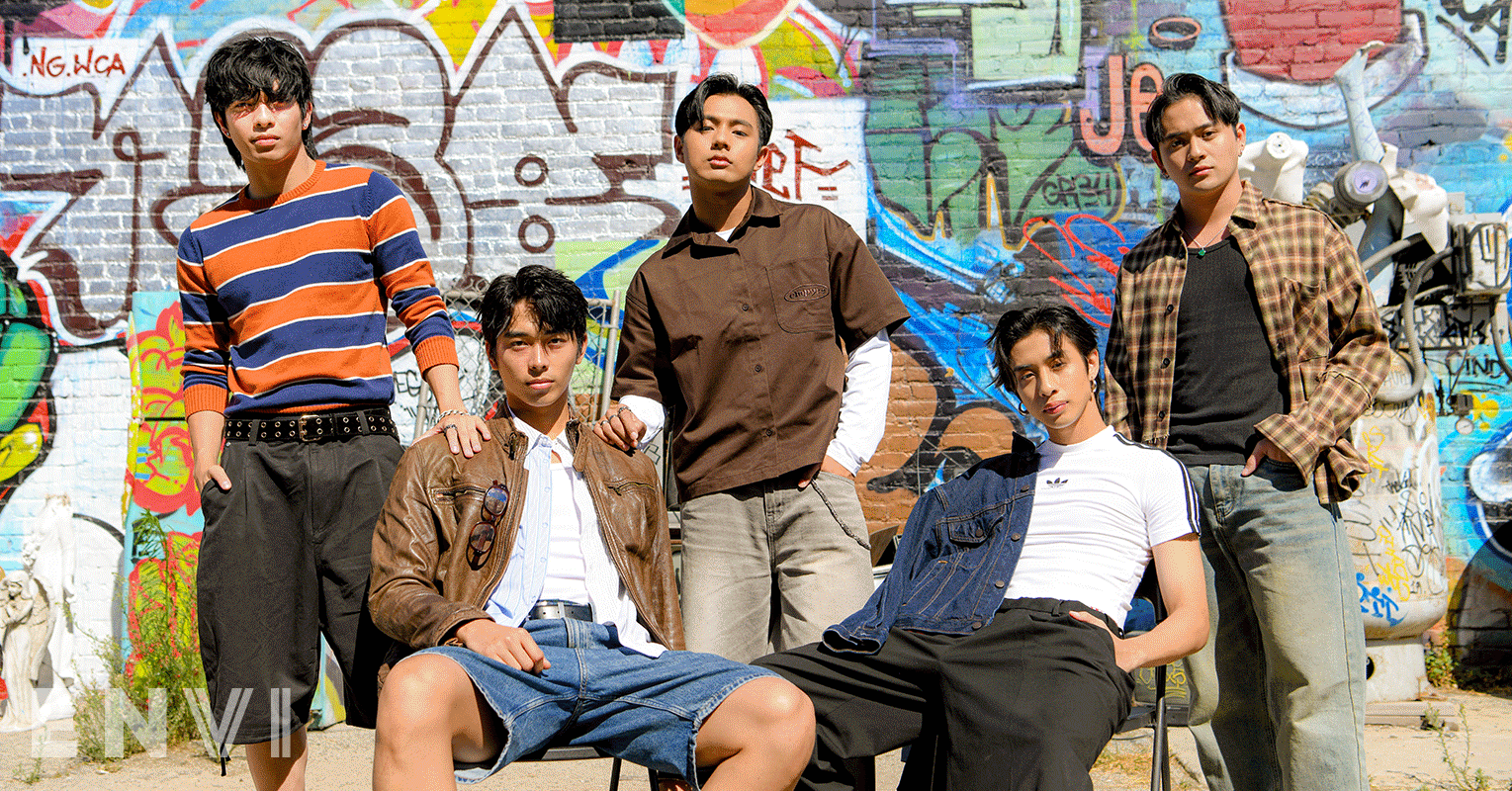“Pulling the Plug” Exhibition at Taipei Dangdai Shines a Light on Technology & Taiwanese Excellence
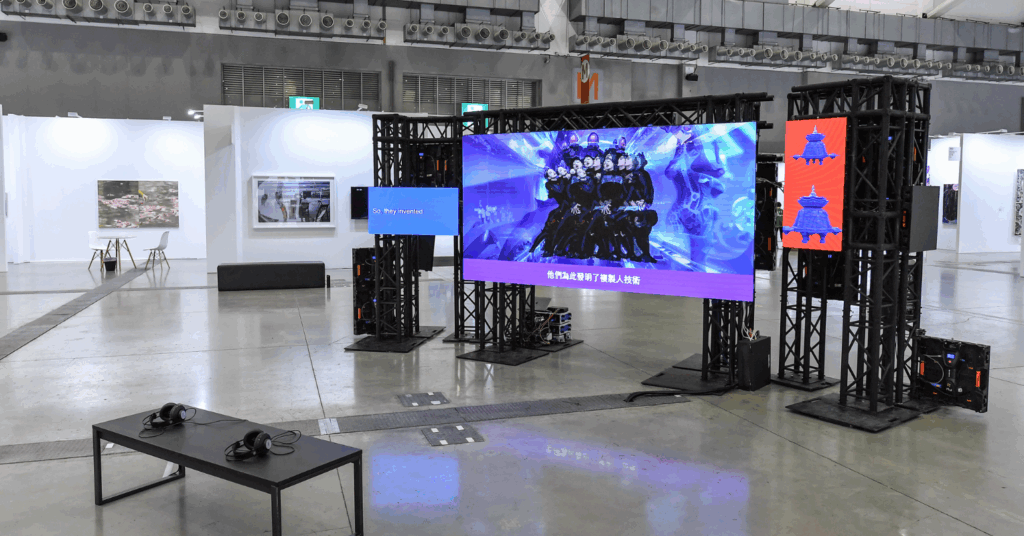
On May 9, the global art fair in Taiwan ushered in its sixth edition. Taipei Dangdai Art & Ideas (台北當代), an event held since 2019, gathers together leaders, movers, and shakers across the art industry. Over three jam-packed days, Taipei’s Nangang Exhibition Center becomes a vibrant gathering space for both local and international galleries, emerging and veteran artists, as well as boundary-pushing installations.
Taipei Dangdai also hosts their talk series, the Ideas Forum, guided tours during the fair, and Taipei Node, reserved for an “up-and-coming Taipei-based artist’s large-scale video installation.” In addition, this year will spotlight a special exhibition co-hosted with Taiwan’s Ministry of Culture titled “Pulling the Plug.” Last year, this exhibition focused on Taiwanese artists was dedicated to spotlight mid-career artists based in Taiwan.
In 2025, “Pulling the Plug” shines a light on the work of new media artist Su Hui-Yu (whose films have appeared at prestigious international film festivals and at Taiwan’s Golden Horse Film Festival), paper sculpture and stop-motion artist Zhang Xu Zhan (whose “Termite feeding show” is an official selection at the International Film Festival Rotterdam 2025), and legendary artist and filmmaker Shu Lea Cheang (whose four feature films formed a new genre entitled Sci-Fi New Queer Cinema, among other notable achievements). Through their projects, which all lean into a science fiction angle, the three artists present cutting questions that dig into our digital age and the role of technology in our lives.
Pulling the Plug in Taipei
A phrase such as “pulling the plug” sends an image of disconnection, of lights immediately cut out flashing through my brain. There is an urgency to this act of force; there is intention. There is also a tinge of violence to cutting a connection between two entities — whether it is a computer to an outlet or a person to their culture.
Given the stamp of approval by Su Hui-Yu, one of the participating artists in the exhibition, “Pulling the Plug” at Taipei Dangdai seeks to highlight our rapidly changing world and its equally rapidly changing relationship with technology. The artists — Su, Shu Lea Cheang, and Zhang Xu Zhan — urge viewers to, above all things, ask questions. This exhibition is a wake up call created through minds, bodies, and technology available at our disposal. EnVi spoke with Shu Lea Cheang and Su Hui-Yu over email and Zoom, respectively, about “Pulling the Plug” and their processes in creating the works exhibited. (Due to scheduling conflicts, Zhang Xu Zhan was not able to comment on the exhibition.)
When Taipei Dangdai goers enter the exhibition hall, Zhang’s short film is the first thing that greets them. From the get-go, the sixth annual art fair refuses to shy away from showcasing the unsettling and the less “aesthetic” art of the world. By placing this video piece about termites at the forefront — with cartoon-like aliens invading a future earth to an EDM beat and a never-ending mutating portrait appearing soon after — “Pulling the Plug” demands attendees’ attention.
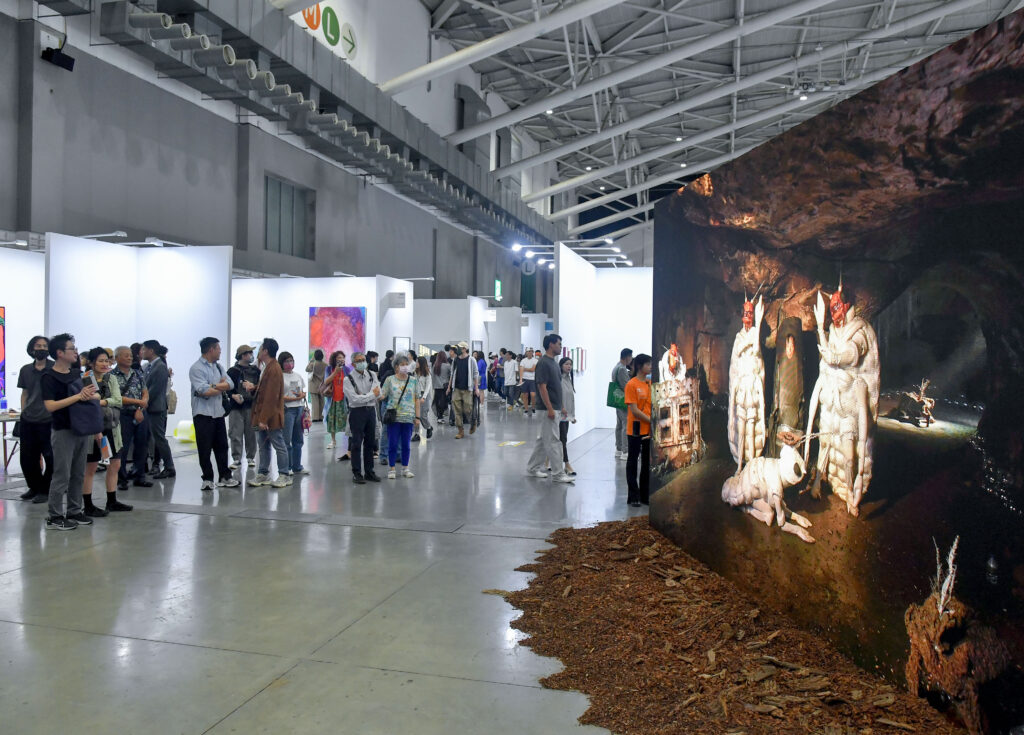
In addition, through “The Space Warriors and the Digigrave,” Su reflects on military propaganda from Taiwan’s martial era. (Spanning from 1949 to 1987, the martial law era in Taiwan was one characterized by extremism, fear, and loss of freedoms.) Su uses a colorful sci-fi series from the 1980s called The Space Warriors, a show associated with “very strong memories” from when he was a child, as a vessel to re-examine this oppressive time in Taiwanese history.
The show gives less-than-subtle “hint[s] about the government protecting our people” against an outside invasion, an “other,” Su noted. Now in 2025, this topic is particularly relevant. The original Space Warriors underscored themes of nationalism, patriarchy, and “promot[ing] governments,” reflecting the logic we often see within right-wing parties right now. Just like Su pointed out, “We need to use this narrative [found in The Space Warriors] again to remind us it shouldn’t be like this.” Instead, “we can create diversity; we can create a dialogue, [a] diversity.”
Su’s recent projects focus on the idea of “re-shooting.” A term borrowed from the film industry, re-shooting refers to when “something goes wrong with one thing in the film, in the sequence, [it’s] no good. You have to go back to review the film and re-shoot,” Su explained to EnVi. “I use this idea as a metaphor of my personal history or memory or rebuilding in my art creation.” This “revisiting,” often with a queer lens, is particularly significant to Su’s identity as a Taiwanese person. “Nowadays we spend a lot of time reviewing either [our] identity or to review the history of the narrative of the country.” Su also emphasized, “I don’t want to give people an answer, but I try to force myself and also force the people who have the chance to watch it to review our values.”
Humans and Tech / Tech and Animals
Paris-based Shu Lea Cheang, who has been an active artist since the 1980s, brings a “genre-bending, gender-hacking” piece to Taipei Dangdai 2025 through “UTTERING.” Created in 2023, the six-and-a-half video loop feels never-ending, as the human figure (shown from the waist up) on the screen changes hair color, eye shape, body proportions, and more with each passing inhale and exhale. “‘UTTERING’ is a programmed portrait staged as a ‘moving’ painting. It can fit into art worlds’ picture/frame hanging practices,” Cheang wrote to EnVi over email.
“UTTERING” may seem deceptively simple upon first glance; however, you slowly begin to realize that you cannot stop watching. There is nothing for your eye to land on, to absorb for more than a flash of a moment. The artist also emphasized, “‘UTTERING’ in the context of Taipei Dandai presentation has to be larger than life; it is presented with 100 LED screens on two sides that measure 5mx5m scale.” This “self-portrait of an artificial intelligence (AI),” which Cheang describes as a “human torso in programmed contortion and mutation,” does not have a single visual identity. We, as human beings, tend to remember a person based on their physical attributes. But what if those features “never stop changing,” as Cheang asks in this work. What if “skin colour, eye colour, hair colour, body shape and gender” are “all morphing in a continuous loop?”
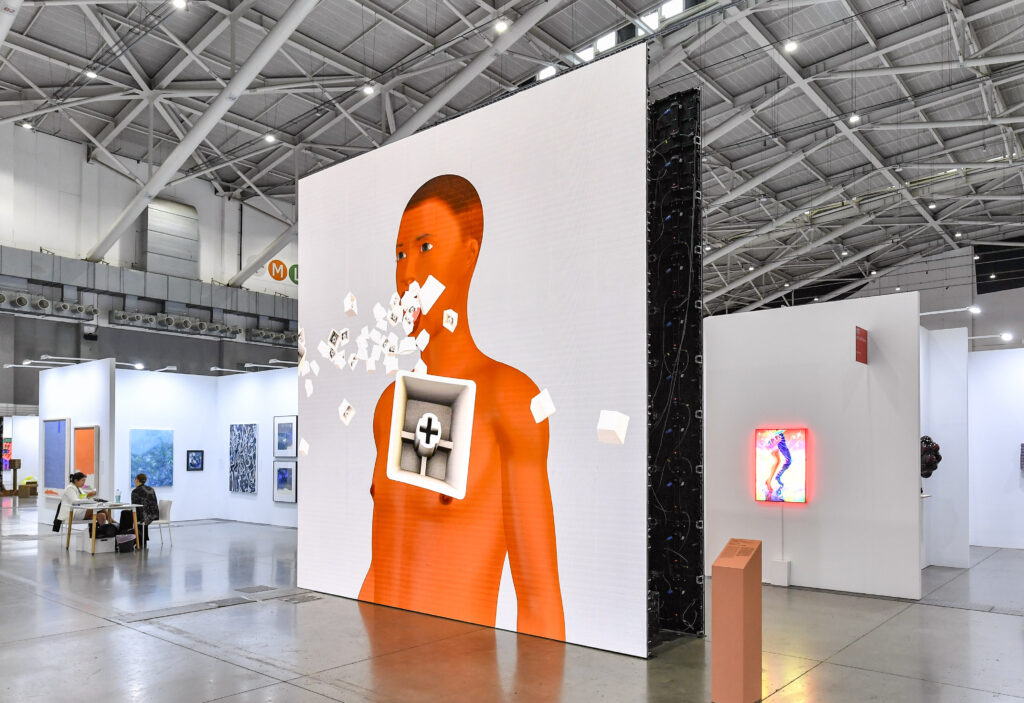
Zhang Xu Zhan works from the opposite end of the spectrum: instead of continuous movement, the actions in “Termite feeding show” seem almost deliberately slow and measured. Yet, similar to Su and Cheang’s work, Zhang also investigates questions revolving around “morphing” and reflecting on the world’s increased reliance on technology. Based on a true news story about termites causing a power outage in Taiwan, Zhang took this to the next level. In his near-future world captured via a short film, termites sustain a cable cord diet. So much so that they host “cooking shows” featuring the slicing up of the cords in underground tunnels.
At Taipei Dangdai, the work was shown on two back-to-back monitors surrounded by a layer of dirt and wood chips. Larger pieces of bark were also carefully arranged around the space as another way to bring the audience into the story. Although Zhang is most known for his paper-crafting work (his family are traditional paper artisans in Taiwan), “Termites feeding show” weaves together this artistic practice with actors performing the heart of the story as termites and as a human-faced cord. There is a dark sense of humor, a leaning into this unexpected happening that only heightens when viewers hear a termite start to play a jaunty piano theme.
Discovery Through the Strange
There is always something to be learned when faced with absurdity. Cheang, Zhang, and Su force their audiences to confront the future — often with firm foundations in the past — by reconsidering histories, whether personal or cultural. They test the unknown, the almost could be, through “strange” forms (termites filming a cooking show, anyone?) and their interaction with contemporary tools like AI.
Take Cheang’s “UTTERING” for example: a bright yellow baby pacifier clenched between the lips of the figure suddenly morphs into a red gag ball. Since the other parts of the body — for example, eye color and shape — are perpetually in motion, the audience almost becomes numb to these subtle changes. However, when the yellow becomes red, it comes as a shock, a realization that “wait, something did change.” This “ever-morphing” aspect to “UTTERING” is critical to the art piece. Cheang shared, “I am activated and in motion, virtually playing a part [in a] real life motion capture yet to be rendered. Ever morphing conveys the concept of gender fluidity, the undefinable, unsettling self in ever-formation.” It is a “self-portrait that defies binary genders and goes color blind on racial ID.”
Termites, meanwhile, are creatures capable of creating cooking shows in Zhang’s short film. The cable cord is not a passive object, however. Instead, it has a human-like personality, as an actual face (the actor) pokes out in the middle of the costume. This cord appears a bit dazed, a little dirty, and definitely aware of its situation but has no power to do anything about it. A few minutes into the film, two termites are tasked with guarding the cord and also pulling the individual copper wires out, too. Stop motion sections highlight the violence of the act through the quick succession of shots.
To bring his raunchy “The Space Warriors and the Digigrave” to life, Su worked with the digital collective XTRUX (pronounced “ex-trucks”). Together, they worked on the project starting from 2022. Since its inception three years ago, The Space Warriors and the Digigrave has been shown in Europe and now Taipei. But the piece is never quite “finished.” The artists make changes — whether small or significant — every time the piece is shown in a different place, creating unique versions while still presenting the same foundational questions.
Beyond What You See
“Stop thinking.” These two small words flash on a screen adjacent to Su’s “The Space Warriors and the Digigrave.” In a way, the audience is encouraged to “stop thinking” when faced with the three video installations at the “Pulling the Plug” exhibition. There are hypnotic qualities to the projects that then inspire viewers to question why their eyes are seeing certain things at certain times and why their ears are hearing certain things at certain times.
At every moment, Su’s installation gives us something to dart our attention to, whether it is the dramatic yet tongue-in-cheek fight scenes, the English translations flashing on a smaller screen, or the hazy editing at select times which reflects a state of mind-numbing desire. In Cheang’s “UTTERING,” too, you are drawn into the constant movement. In fact, viewers have to watch the body to see the “breath” that the torso takes. However, it is curious to note that the mouth is always static, due to the pacifier, the gag, and, lastly, the computer keys spewing from it.
When I took in Zhang’s “Termite feeding show,” it wasn’t the costumed termites that unsettled me the most — it was the sound. From the costume material scraping the hard-packed dirt to the termites dragging a knife back-and-forth on the cable, every little movement was heard in the best quality. It was more crystal clear than crystal clear. The viewers are so deeply brought into the story that we are truly unable to half-heartedly watch or listen, which makes the experience all the more powerful.
In addition, the thought process behind “UTTERING” adds more layers and nuances to a piece that rarely lets the viewers themselves breathe. Cheang developed this video loop to pose questions about AI algorithms. “‘UTTERING’ is created to challenge race and gender algorithms in AI’s learnt formation and programmed with a set of parameters that are variable — in terms of skin color, body type, eye shape, eye color,” she wrote to EnVi.
“The AI is fed by big data as managed by controlling parties,” Cheang added. The artist spoke to our current world’s growing reliance on AI, noting, “We can also ‘raise/feed’ our own AI. AI is ruled by AI alignment, a process of encoding preconceived behaviour models into AI’s programmation.” As written in her artist statement at the fair, “UTTERING” further explores “whether AI is able to grasp the complexity and fluidity of human identities beyond reductive views such as binary genders.”
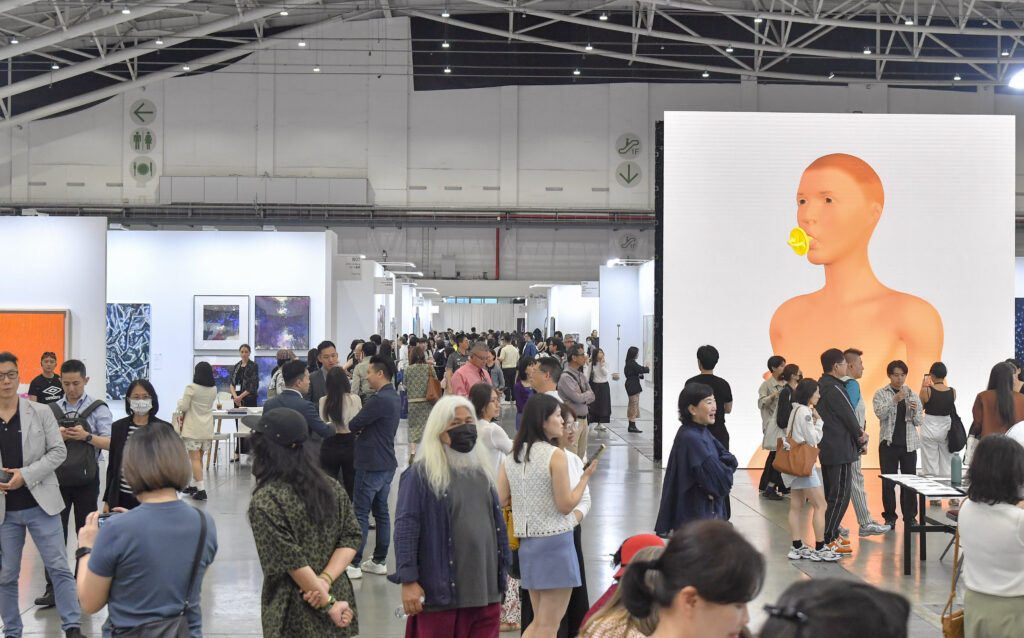
Su prompts questions surrounding AI in a different way. He and XTRUX integrate AI into “The Space Warriors and the Digigrave” in an intentional way that only emphasizes the popular tool’s unnaturalness. “It looks so unreal,” underscored Su. In 2022 when the artist and the digital collective began working on the project, AI was already taking off. However, in the three years since, the AI world has changed by leaps and bounds. “The Space Warriors and the Digigrave” reflects this new reality, as Su and XTRUX change pieces of the project in tandem with the changes found in the AI world. Although they used a film camera to capture the acting, they used AI for the animations (as a result, they didn’t need a motion capture suit) and for most of the backgrounds.
“Termite feeding show” homes in on another intersection between the natural world and the impact of technology on it. In the artist statement featured at the fair, these termites needed to “adapt to sudden ecological changes brought about by climate change.” The cooking show format Zhang takes, meanwhile, “serves as a sacrificial offering to the gods of ecology and an act of revenge against humanity.”
We Can All “Pull the Plug”
So how do “UTTERING,” “Termite Feeding Show,” and “The Space Warriors and the Digigrave” all “pull the plug,” so to speak? In six-and-a-half minutes, viewers now have a vehicle in which to visualize just who feeds AI, and how we feed AI with our constant use of it. There is a violence behind this limitless morphing as bones shift and eyes contort into different shapes, all while the mouth of the figure remains firmly blocked. Cheang pulls the plug on AI and the crumbling of personal identity, which is often intertwined with the individualism of our bodies.
Su pulls the plug on collective memory, specifically the memory surrounding science fiction during the martial law era. The artist queers the narrative originally used as a vehicle for military propaganda and pushes queerness to the forefront of history as well. In a story where brightly colored “heroes” collaborate with the military to ensure everyone on earth is working hard — and only working — Su pulls the plug on this memory of the media.
When glancing around at other Taipei Dangdai attendees watching “Termite feeding show,” their wide eyes revealed the magnetism of Zhang’s video installation. He pulls the plug on our desire to ignore the unusual effects of climate change and technology on the natural world. As we witness a gruesome process showcased in Zhang’s fictional story, we have to also question where do we think our world will end up?
Of course, with a unique exhibition title such as “Pulling the Plug,” the artists who spoke with EnVi had some thoughts about what it means to them. Cheang noted that the curators might want to “challenge the norm by presenting cutting edge works” that risk being pulled from the spaces that house them. “UTTERING,” “The Space Warriors and the Digigrave,” and “Termite feeding show” are undoubtedly “cutting edge works,” which also encourage viewers to speak up and speak out about the past, present, and future.
In Su’s opinion, there is a juxtaposition going on in “Pulling the Plug.” Not only do the three selected artists all integrate new media into their practices, but their work definitely needs a computer and LED monitors to allow viewers to engage with their art. Meanwhile, the curators at Taipei Dangdai essentially say, “Let’s switch the plug off” for this exhibition.
Besides the literal sense of the name, Su also sees it as a warning. “It’s not about the technology,” he stated. “New media art is not about new media.” At the end of the day, Su, Cheang, and Zhang are all working with technology and art installations to express similar threads of ideas. As Su emphasized wholeheartedly, “Actually, the humanity is the core.”
Taipei Dangdai is currently running until May 11. You can purchase tickets for the last day of the fair on Klook. Keep updated on new Taipei Dangdai information by subscribing to their newsletter, following their Instagram, and checking out their Facebook page.
Want to read more about Taipei Dangdai? Check out 8 highlights from last year’s fair here!

